Painful procedures
So that the animals can be controlled and labelled, and so they won't 'damage' one another, the subjugation of cows starts when they are just babies. Calves are subjected to a variety of painful surgical procedures without anaesthesia. These include castration (physical removal of the testicles), branding with scorching irons, and removal of their horns. These are standard practices across the industry.
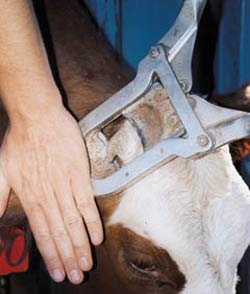
Cow being dehorned using a cup dehorner. Source: NSW Government
Dehorning/disbudding:
Dehorning is the removal of a cow or calf's horns to make them easier to control and less likely to 'damage' one another's flesh or hide, which would reduce their carcass quality. When performed on calves, before the horn buds have attached to the skull, the procedure is called 'disbudding'. Both procedures are commonly performed in the absence of any pain relief (page 21), causing agonising acute pain to the animal.
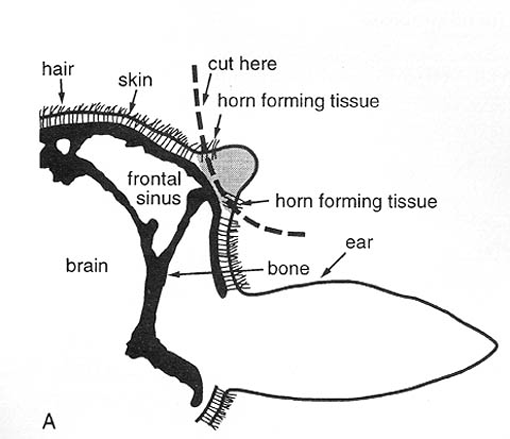
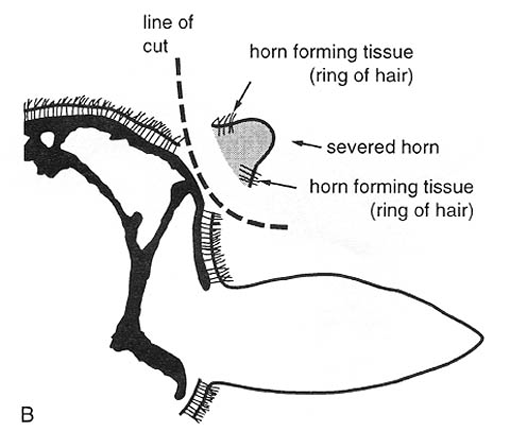
Disbudding is usually performed by pressing a hot iron into the skull where the budding horns are, killing the tissue, so that horns will never grow. Without the use of any sedatives or pain relief, disbudding is considered to cause severe acute pain. There is an acute pain response following the procedure which peaks at 30 minutes and can last for 8 hours. Further, if excessive heat is applied during disbudding, damage can be done to the underlying bone. One study found that disbudded calves engaged in less play behaviour post disbudding which suggests ongoing pain. There are no incentives for farmers to use pain relief, in an industry driven by profit, as it makes the procedure far more costly for them.
Dehorning is the removal of the horns of cattle by cutting through the bone and horn tissue. Cattle forced to undergo this procedure experience excruciating acute pain. In exposés of this procedure, cattle can be seen screaming out in pain as their horns are cut off. Cattle subjected to dehorning have been observed displaying behaviours associated with pain post-surgery. These behaviours include head shaking, ear flicking, neck extension, tail flicking increased lying and rising and reduced rumination.
There are several methods used by the industry to carry out dehorning. The Australian Animal Welfare Standards and Guidelines for Cattle, outlines that cattle under the age of 6 months old can be dehorned without the use of pain relief. The use of pain relief would significantly increase the cost of this procedure; for this reason, cattle are mostly dehorned in their first 6 months of life without any pain relief. Dehorning is usually undertaken whilst the animal is restrained in a 'calf cradle' or a 'crush'. For calves up to two-months old, industry-recommended methods to dehorn cattle include hot iron, knife, spoon or tube. For older calves and weaners, the two most common methods used are a dehorning cup or scoop.
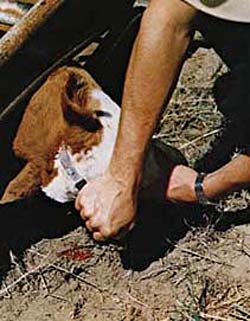
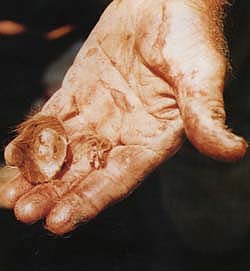
Source: NSW Government.
The horns of cattle have a hollow centre, which opens into the frontal sinus. Dehorning increases the risk of sinusitis, bleeding and infection, with wounds often slow to heal. Physical dehorning also increases the risk of transmitting bovine leukosis virus (BLV), which can result in tumours, from 8% to 77% when gouge dehorning is used. It has been reported that bovine cutaneous papillomas, a viral disease characterised by multiple skin tumours or growths, has developed in calves post-dehorning due to physical transmission of the virus through equipment. Cattle have also been found to be affected by tetanus, a bacterial infection, post-dehorning.
Castration:
Castration is the removal of a male animal's testicles. Like dehorning, it is legal to perform castration on cattle under the age of 6 months without the use of pain relief or anaesthetic.
All physical methods of castration have been found to cause ongoing pain for cattle. During/post-castration cattle have been observed kicking their hind legs, struggling, tail swishing, stamping their feet, head turning, displaying restless behaviour, walking with a stilted gait, having reduced activity, standing abnormally and eating less, which are all strong indicators of pain.
 Standards for castrating cattle. Source: Australian Animal Welfare Standards and Guidelines.
Standards for castrating cattle. Source: Australian Animal Welfare Standards and Guidelines.
There are 3 main methods used to castrate cattle:
- Surgical
- Elastrator rings
- Burdizzo (Bloodless castration pincers)
Cattle are restrained in the calf cradle or crush for the procedure. When being castrated using the scalpel method, the testicles are forced against the scrotum to stretch the skin; the skin is sliced open and the testicles are removed.
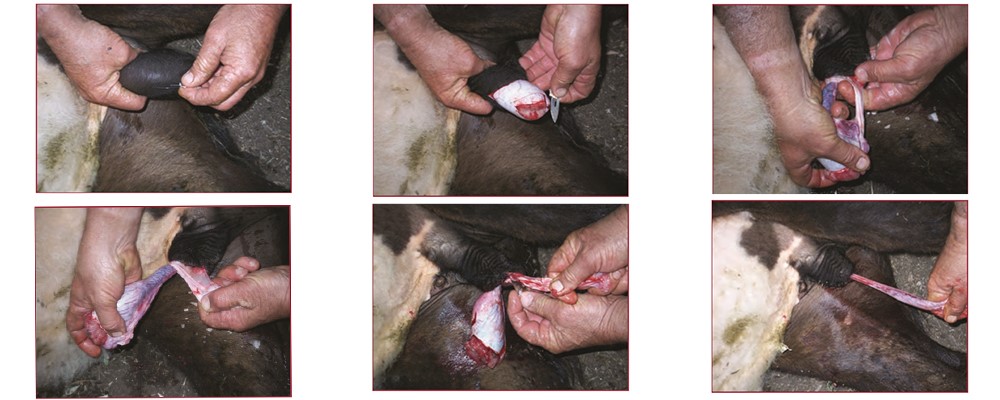
Castration using surgical method.
The ring method that is recommended for calves under 2 weeks old, involves placing a ring around the base of the testicles to cut off the blood supply to the scrotum and testicles. The tissue below the band will die and drop off. This causing ongoing pain and discomfort to cattle subjected to this procedure.

Castration using the band method.
Castration by crushing the spermatic cord is done using an instrument that clamps down tightly over the spermatic cord on each testicle twice (four clamps total) for 10-20 seconds each time.
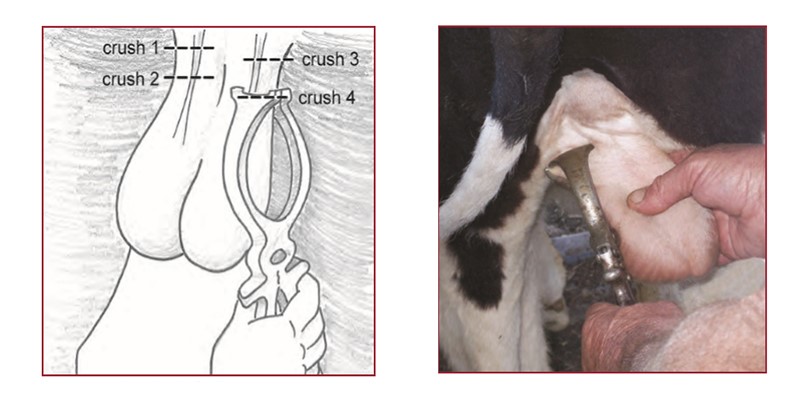 Castration by means of crushing the spermatic cord.
Castration by means of crushing the spermatic cord.
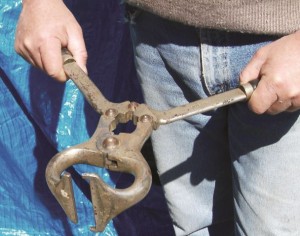
All of these castrating methods are most commonly preformed on calves 6 months or younger as they are easier to restrain and costs are saved by avoiding any legal requirement for pain medication. However, cattle can often have castration preformed on them without pain relief if they are under 12 months and it is their first yarding.
Branding:
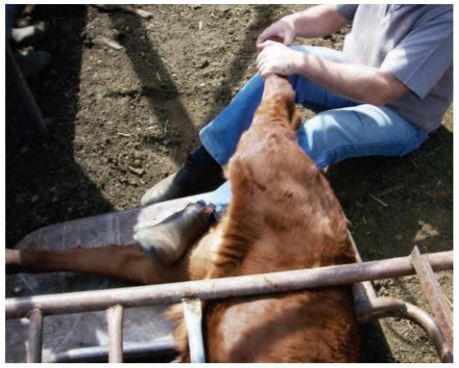 Cattle being restrained in a 'calf-cradle' for branding Source: Meat and Livestock Australia.
Cattle being restrained in a 'calf-cradle' for branding Source: Meat and Livestock Australia.
Branding is the placement of permanent identifying mark on the body of cattle. Farmers brand their cattle to make it easy to establish 'ownership' of them. In some states and territories it is a legal requirement that cattle be branded, with legislation outlining the position, size and age of the animal at the time of branding.
Cattle forced to undergo branding for the purpose of identification display behaviours associated with acute pain during the procedure; these include vocalisation, kicking, and tail flicking.


Hot iron branding acts to destroy the hair follicles in the area and leave a permanent scar.The hot iron is pressed firmly onto the animal's hide for 3 seconds, forming a clear mark on them. This is a painful procedure, performed without the use of pain relief. Hot iron branding is known to cause pain to cattle for some time after it is performed.
Freeze branding is the use of super-cooled liquid nitrogen to destroy skin and hair cells that produce pigmentation; this means freeze brands appear as white hair in the place of the brand. The iron is placed in the liquid nitrogen, and then on the restrained animal's body for 15-40 seconds. The use of freeze branding is said to cause less pain to the animal at the time of branding, however, studies have shown that third-degree burns can still occur, and the healing times still lasts for 6-8 weeks.


